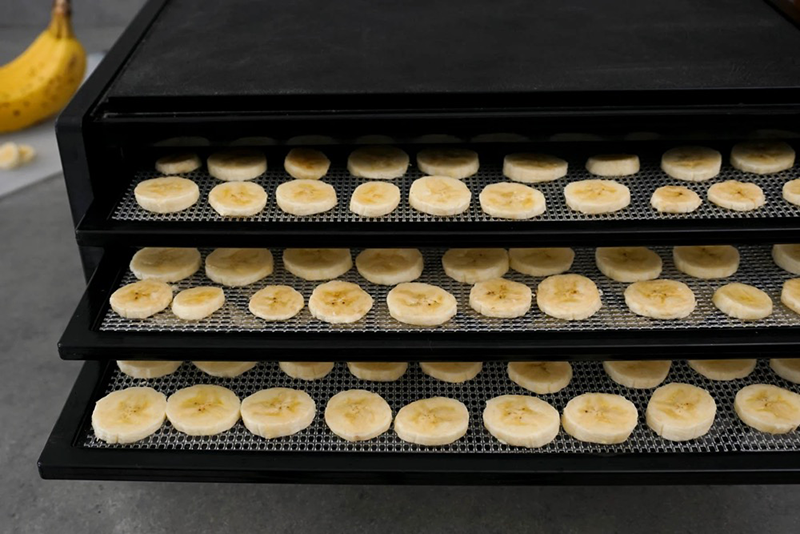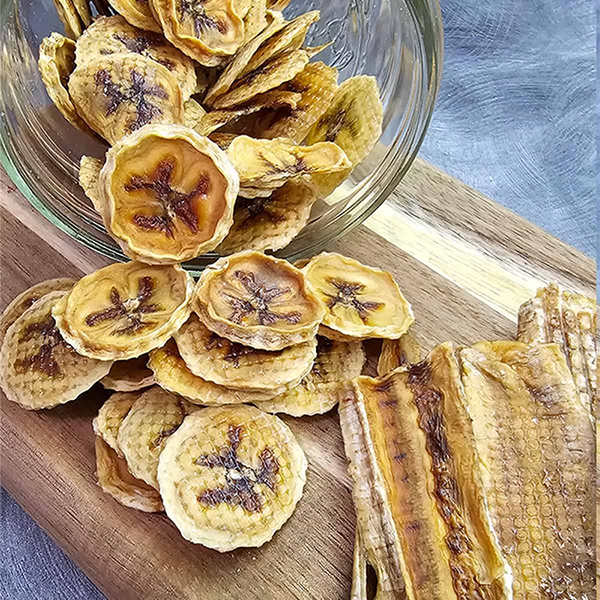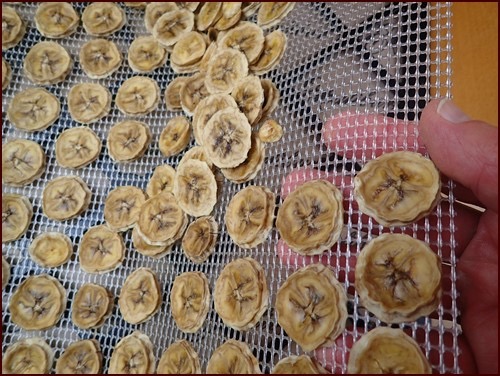
Content Menu
● Benefits of Dehydrating Bananas
● Choosing the Right Bananas
● Equipment Needed
● Preparation Steps
● Dehydrating Process
● Storing Dehydrated Bananas
● Creative Ways to Use Dehydrated Bananas
● Health Benefits of Dehydrated Bananas
● Understanding Different Types of Food Dehydrators
● Common Mistakes When Dehydrating Bananas
● Exploring Other Fruits Suitable for Dehydration
● Tips for Maintaining Your Food Dehydrator
● Conclusion
● FAQ
>> 1. How do I keep my bananas from turning brown when dehydrating?
>> 2. Can I use overripe bananas for dehydration?
>> 3. How long does it take to dehydrate bananas?
>> 4. Can I dehydrate other fruits in the same batch as bananas?
>> 5. What should I do if my dehydrated bananas are sticky?
● Citations:
Dehydrating bananas is a simple and rewarding process that allows you to preserve the fruit's natural sweetness while creating a delicious snack. This guide will walk you through the steps to effectively dehydrate bananas using a food dehydrator, providing tips, tricks, and insights along the way.

Benefits of Dehydrating Bananas
Dehydrating bananas offers numerous advantages:
- Long Shelf Life: Dried bananas can last for months when stored properly.
- Nutrient Retention: Dehydration preserves most of the nutrients found in fresh bananas.
- Convenient Snack: Dried bananas are lightweight and easy to carry, making them perfect for hiking, camping, or on-the-go snacking.
- Versatile Use: Dehydrated bananas can be enjoyed as-is, added to cereals, or incorporated into baked goods.
Choosing the Right Bananas
When selecting bananas for dehydration, consider the following:
- Ripeness: Use ripe bananas that are slightly speckled but not overly soft. This ensures optimal sweetness and flavor.
- Quality: Choose fresh bananas without bruises or blemishes to achieve the best results.
Equipment Needed
To dehydrate bananas effectively, you will need:
- A food dehydrator with adjustable temperature settings.
- A sharp knife or mandoline for slicing.
- A cutting board.
- Optional: lemon juice or a fruit preservation solution to prevent browning.
Preparation Steps
1. Wash Your Hands and Equipment: Ensure cleanliness to avoid contamination.
2. Peel the Bananas: Remove the peel from each banana and discard it.
3. Slice the Bananas: Cut the bananas into uniform slices about 1/4 inch thick. Consistent thickness ensures even drying.
Slicing Bananas
4. Optional Pretreatment: To prevent browning, soak the banana slices in a mixture of water and lemon juice (1 tablespoon of lemon juice per cup of water) for about 15 minutes.
Soaking Bananas
5. Dry the Slices: Pat the banana slices dry with a paper towel if soaked.
Dehydrating Process
1. Arrange Banana Slices: Place the banana slices in a single layer on the dehydrator trays. Ensure they do not touch each other to allow proper airflow.
Arranging Banana Slices
2. Set Temperature: Turn on your food dehydrator and set it to 135°F (57°C). This temperature is ideal for drying fruits while preserving their flavor and nutrients.
3. Dehydrate: Allow the banana slices to dehydrate for approximately 6 to 12 hours. The exact time will depend on several factors including humidity and thickness of slices.
Dehydrating Process
4. Check for Doneness: Every few hours, check the banana slices for dryness. They should be leathery and not sticky when done. If they feel moist, continue dehydrating.
5. Rotate Trays: If your dehydrator has multiple trays, rotate them every few hours for even drying.
Storing Dehydrated Bananas
Once dried, allow the banana chips to cool completely before storing them in airtight containers such as mason jars or vacuum-sealed bags.
- Conditioning: For best results, condition your dried bananas by placing them in a large container for a week, shaking daily to ensure even moisture distribution.
Creative Ways to Use Dehydrated Bananas
Dehydrated bananas are not just snacks; they can be used in various culinary applications:
- Trail Mixes: Combine with nuts, seeds, and other dried fruits for a nutritious trail mix.
- Baked Goods: Incorporate into muffins, bread, or cookies for added flavor and texture.
- Smoothies: Blend into smoothies for natural sweetness without added sugar.
- Cereal Topping: Add to your morning cereal or oatmeal for extra flavor and nutrition.
- Homemade Granola Bars: Use as an ingredient in homemade granola bars for a chewy texture and natural sweetness.
Health Benefits of Dehydrated Bananas
Dehydrated foods retain most of their nutrients while providing several health benefits:
- High Fiber Content: Dehydrated bananas are rich in dietary fiber, which aids digestion and helps maintain gut health.
- Natural Energy Boost: The concentrated sugars provide a quick energy boost, making them an excellent snack before or after workouts.
- Low in Fat and Calories: Dried fruits like bananas are low in fat and calories compared to many processed snacks, making them a healthier choice.
- Rich in Antioxidants: Dehydration helps preserve antioxidants present in bananas that combat oxidative stress in the body.
Understanding Different Types of Food Dehydrators
Food dehydrators come in various types—each offering unique features that cater to different needs:
- Stackable Tray Dehydrators: These typically consist of multiple trays stacked on top of each other. They are compact and suitable for small batches but may require rotating trays during use for even drying.
- Shelf Dehydrators: These models have shelves that slide out like an oven rack, allowing easy access to food items without disturbing others.
- Excalibur Dehydrators: Known for their superior airflow design, these dehydrators provide consistent drying results across all trays without needing rotation.
Understanding these options can help you choose the right dehydrator based on your volume needs and available space.

Common Mistakes When Dehydrating Bananas
Avoiding common pitfalls can enhance your dehydration experience:
- Inconsistent Slicing: Unevenly sliced bananas will dry at different rates; aim for uniform thickness.
- Overcrowding Trays: Placing too many slices on one tray can hinder airflow and lead to uneven drying.
- Skipping Pretreatment: Neglecting to pretreat banana slices can result in browning; always consider using lemon juice or citric acid solutions.
Being aware of these mistakes can save time and improve your final product quality significantly.
Exploring Other Fruits Suitable for Dehydration
Bananas are just one option among many fruits that can be dehydrated effectively:
- Apples: Slice thinly; they make great snacks when sprinkled with cinnamon.
- Pineapples: Cut into rings or chunks; they offer a tropical flavor that's delightful.
- Mangoes: These provide a chewy texture when dried; slice thinly for best results.
Each fruit has its unique characteristics that affect drying time and texture—experimenting with different fruits can yield exciting new snacks!
Tips for Maintaining Your Food Dehydrator
To ensure longevity and efficiency from your food dehydrator:
- Regularly clean all trays after use to prevent residue buildup.
- Store your dehydrator in a dry place away from moisture.
- Check seals on trays periodically; ensuring they fit snugly helps maintain optimal airflow during dehydration.
Taking care of your equipment will enhance its performance over time!
Conclusion
Dehydrating bananas is an excellent way to enjoy this nutritious fruit long after its peak freshness has passed. With just a few simple steps and some patience, you can create delicious snacks that are perfect for any occasion. The process not only preserves the fruit but also enhances its natural sweetness and creates versatile options for various recipes.

FAQ
1. How do I keep my bananas from turning brown when dehydrating?
To prevent browning, soak banana slices in an acidulated solution (water mixed with lemon juice) before dehydrating them.
2. Can I use overripe bananas for dehydration?
Yes! Overripe bananas can be used; they will yield sweeter results but may have a different texture once dried.
3. How long does it take to dehydrate bananas?
The dehydration process typically takes between 6 to 12 hours at 135°F (57°C), depending on slice thickness and humidity levels.
4. Can I dehydrate other fruits in the same batch as bananas?
While it's possible, it's best to dehydrate fruits with similar drying times together to ensure even results.
5. What should I do if my dehydrated bananas are sticky?
If your dried bananas are sticky, they may need more time in the dehydrator or might require conditioning before storage.
Citations:
[1] https://flouronmyface.com/how-to-dehydrate-banana-chips/
[2] https://www.attainable-sustainable.net/make-chewy-dehydrated-bananas-snacking/
[3] https://terradomilho.eu/2019/03/the-advantages-of-dehydrating-fruit-and-vegetables/
[4] https://www.kotibeth.com/2021/08/how-to-dehydrate-bananas.html
[5] https://www.freshoffthegrid.com/dehydrating-bananas/
[6] https://www.webmd.com/diet/dehydrating-food-good-for-you
[7] https://realfoodrealdeals.com/homemade-banana-chips/
[8] https://www.backpackingchef.com/dehydrating-bananas.html
[9] https://airtekdehydrator.com/health-advantages-using-food-dehydrator/
[10] https://www.dehydratedelight.com/fruits/how-to-dehydrate-a-banana-2/











